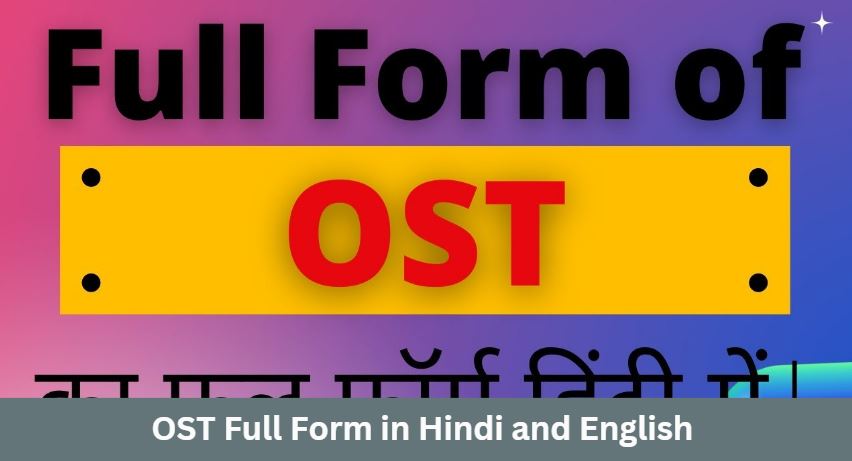OST Full Form! In the vast realm of acronyms and abbreviations, OST stands as a notable contender, often encountered in diverse contexts ranging from technology to medicine. While its meaning may vary depending on the field, one of the prevalent interpretations of OST is “Original Sound Track” or “Original Soundtrack.” This term finds prominence particularly in the realms of music and cinema, representing the primary musical composition created specifically for a movie, television series, video game, or any other visual media project.
The concept of OST traces its roots back to the early days of cinema when silent films dominated the silver screen. During this era, live music was commonly performed alongside screenings to provide accompanying sound and enhance the audience’s viewing experience. However, with the advent of sound in movies, the need for pre-recorded soundtracks arose. Max Steiner’s groundbreaking score for “King Kong” (1933) is often cited as one of the earliest instances of a comprehensive musical score tailored explicitly for a film.
As the film industry burgeoned, the importance of OSTs became increasingly evident. Composers such as Ennio Morricone, John Williams, and Hans Zimmer emerged as icons, known for their ability to craft captivating musical compositions that seamlessly intertwined with visual narratives. The evolution of technology further revolutionized the creation and distribution of OSTs, with advancements in recording techniques and digital formats enabling composers to explore innovative sonic landscapes.
What Does OST Stand For?
OST stands for “Original Soundtrack” or “Original Sound Track.” It refers to the music or sound that is specifically composed or arranged for a particular film, television show, video game, or any other multimedia project. The OST plays a crucial role in setting the mood and enhancing the overall experience for the audience. It often includes background music, theme songs, and instrumental compositions, created by talented composers and artists. The songs and melodies in an OST often become memorable and iconic, leaving a lasting impression on the viewers or listeners. OSTs are released as albums or made available for streaming on various platforms, allowing fans to enjoy the music outside of the media project itself. Additionally, OSTs are eligible for various awards in the entertainment industry, recognizing the contributions of composers and musicians to the world of visual media.
OST Full Form in English
The term “OST” denotes “Original Soundtrack,” serving as the specialized music or audio crafted for a distinct film, television series, video game, or multimedia endeavor. Revered for its pivotal role, the OST profoundly influences the ambiance and amplifies the audience’s engagement with the visual narrative. Typically encompassing background scores, theme anthems, and instrumental arrangements, the OST emerges from the creative ingenuity of adept composers and artists.
Within the realm of OSTs, compositions often transcend mere auditory accompaniment, assuming the mantle of iconic motifs that resonate deeply with viewers or listeners. These melodic arrangements etch indelible impressions, becoming emblematic of the associated media and enduring long after the initial encounter.
OST Full Form in Hindi
ऑएसटी का पूरा नाम “ऑरिजिनल साउंडट्रैक” (Original Soundtrack) है। यह शब्द फिल्म या टेलीविजन शो के लिए उपयोग होता है ताकि वहाँ इस्तेमाल होने वाली सभी संगीत, गीत और संगठन को समेटा जा सके। ऑएसटी, जिसे हिंदी में अनुवादित किया गया है “मूल संगीत मंच” या “मूल ध्वनि प्रस्तुति” के रूप में, चरित्रित किया जाता है। यह शब्द महान या मशहूर गीतों को भी संकोचित रूप से उपयोग करने का दौर बना सकता है।
Frequently Asked Questions
What does OST stand for?
OST stands for “Original Soundtrack” or “Original Sound Track.”
What is an OST?
An OST refers to the music or sound specifically composed or arranged for a particular film, television show, video game, or any other multimedia project. It encompasses background music, theme songs, and instrumental compositions.
Why is an OST important?
The OST plays a crucial role in setting the mood and enhancing the overall experience for the audience. It helps to create atmosphere, evoke emotions, and immerse viewers or players into the world of the media project.
Who creates OSTs?
OSTs are created by talented composers, musicians, and artists who specialize in crafting music for visual media. They work closely with directors, producers, and other stakeholders to ensure that the music aligns with the creative vision of the project.
Are OSTs only used in films?
No, OSTs are not limited to films. They are also commonly used in television shows, video games, commercials, and other multimedia projects where music plays a significant role in enhancing the audience’s experience.
Can OSTs become popular or iconic?
Yes, many OSTs have become memorable and iconic over the years. Some songs and melodies from OSTs have achieved widespread recognition and are often associated with the media projects they were created for.
Are OSTs available for purchase or streaming?
Yes, OSTs are often released as albums or made available for streaming on various platforms. Fans of a particular film, television show, or video game can purchase or listen to the OST to enjoy the music outside of the media project itself.
Conclusion
OST, standing for Original Soundtrack or Original Sound Track, encapsulates the essence of music specifically tailored for visual media projects such as films, television shows, video games, and more. As a pivotal component, OSTs not only enhance the overall experience for audiences but also play a crucial role in setting the mood, evoking emotions, and enriching the narrative. Crafted by talented composers and artists, these soundtracks often transcend their original context, becoming iconic and memorable in their own right. Whether through evocative melodies, thematic anthems, or immersive instrumental arrangements, OSTs continue to leave a lasting impression, enriching the cultural landscape and enhancing the storytelling process across various media platforms.
